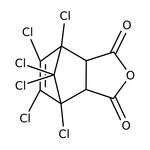Search Thermo Fisher Scientific
Chlorendinsäureanhydrid, 96 %, kann bis zu 3 % Chlorendinsäure enthalten, Thermo Scientific Chemicals



Chlorendinsäureanhydrid, 96 %, kann bis zu 3 % Chlorendinsäure enthalten, Thermo Scientific Chemicals
Chemikalien-Kennzeichnungen
Spezifikationen
Beschreibung
This Thermo Scientific Chemicals brand product was originally part of the Alfa Aesar product portfolio. Some documentation and label information may refer to the legacy brand. The original Alfa Aesar product / item code or SKU reference has not changed as a part of the brand transition to Thermo Scientific Chemicals.
Chloranhydrid wird bei der Synthese von Polymeren verwendet, die bei der Herstellung von glasfaserverstärkten Harzen für Geräte der chemischen Industrie verwendet werden. Kann zur Herstellung von Alkydharzen für die Verwendung in speziellen Tinten und Farben verwendet werden. Wird als Aushärtungsmittel in Epoxidharzen verwendet, die bei der Herstellung von Leiterplatten verwendet werden
Löslichkeit
Unlöslich in Wasser.
Hinweise
Feuchtigkeitsempfindlich. Behälter dicht verschlossen lassen. Kühl und trocken in einem gut versiegelten Behälter lagern.
Abbildungen
Dokumente und Downloads
Zertifikate
Häufig gestellte Fragen (FAQ)
Zitierungen und Referenzen
Sicherheit und Handhabung
Classification of the substance or mixture
CLP classification - Regulation(EC) No 1272/2008
Label Elements
Signal Word
Danger
Hazard Statements
H315 - Causes skin irritation
H319 - Causes serious eye irritation
H335 - May cause respiratory irritation
H350 - May cause cancer
Precautionary Statements
P280 - Wear protective gloves/protective clothing/eye protection/face protection
P302 + P352 - IF ON SKIN: Wash with plenty of soap and water
P304 + P340 - IF INHALED: Remove person to fresh air and keep comfortable for breathing
P312 - Call a POISON CENTER or doctor if you feel unwell
P332 + P313 - If skin irritation occurs: Get medical advice/attention
P337 + P313 - If eye irritation persists: Get medical advice/attention
Additional EU labelling
Restricted to professional users